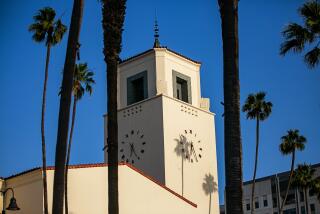Letting It Ride for 20 Years : Union Station Project Incomplete
- Share via
WASHINGTON — Mention Union Station to Rep. Kenneth J. Gray and he reaches for a torn, brown box and starts pulling out dogeared copies of committee testimony.
“There were reports that $100 million was wasted on the project,” says the Illinois Democrat who led the campaign to turn Union Station into the National Visitors Center more than 20 years ago. “Nothing could be further from the truth.”
The idea evolved in the late 1960s, when declining rail passenger traffic forced Congress to decide what should be done with the under-used station.
Some officials suggested razing the old, Beaux Arts-style edifice with its marble floors, mahogany doors and gold-leaf coffers. Others, including Gray, envisioned a National Visitors’ Center with a spacious parking garage for the busy area near the Capitol.
As chairman of the House Public Works Committee, Gray conducted hearings on whether the station should be preserved and transformed into a tourist gateway to Washington.
Parking Space Pressure
“The National Park Service said at that time that we needed a minimum of 10,000 parking spaces on Capitol Hill,” Gray said. “Twenty years later, you can guess how many we need--20,000.”
Gray refers back to railroad officials’ testimony that the government bought 300 acres of air rights for the multilevel garage and got the building at no cost.
The congressman later went on the floor of the House and proclaimed that the project would not cost the taxpayers a penny.
Congress passed the National Visitors’ Center Facilities Act of 1967 and the project got under way with cost estimates at $16 million.
The tracks were hidden in a remote part of the station. A tourist bookstore was added and a film pit was built into the center lobby to show visitors highlights of American history and scenic tourist attractions.
There were construction delays and cost overruns, and on the day of the U.S. Bicentennial celebration, the slide show in the pit broke down.
New Ceiling Crumbled
In February, 1981, falling chunks of plaster forced the Department of Interior to close the center. By that time, renovation costs had mounted to $48 million.
Nine months later, then-Sen. Slade Gorton (R-Wash.) told the Senate: “This project is an embarrassment to the Congress and the executive branch alike. Millions of dollars of public funds were expended to such poor effect that the building was allowed to become structurally unsafe.”
Gray, who had promised that the project would not take tax revenues, took a great deal of the blame for the project’s failure. Recently, he cited factors out of his control.
“I made the statement based on the testimony of the guy who was going to find the money,” Gray said. “After that, Penn Central went into bankruptcy, Amtrak filed a lawsuit--and here’s our own government, an agency of our own government filing a lawsuit against its own Department of the Interior--shutting down that national project. Ken Gray didn’t have anything to do with that.”
Gray retired in 1974, citing health problems, but returned to the House in 1984.
‘No White Elephant’
“After I got out of Congress, they called it ‘Gray’s white elephant,’ ” he said. “It was not a white elephant. It was an incompleted project, and they were within $4 million of finishing the parking garage.
“Now they’re spending $42 million of the District’s money to finish a $4-million project. You call that a meritorious expenditure of public funds?”
Construction of the 1,200-car, 80-bus garage also has had its share of problems.
Last year, the District of Columbia, which is responsible for the project, terminated the contract with the Maryland builder of the garage, citing the company’s failure to complete the work on time. Construction was halted with 72% of the work done.
Ira Steinberg, president of Kora & Williams Corp. of Silver Spring, Md., said the company was shocked by its loss of the contract and planned to challenge the action.
More to Read
Sign up for The Wild
We’ll help you find the best places to hike, bike and run, as well as the perfect silent spots for meditation and yoga.
You may occasionally receive promotional content from the Los Angeles Times.






